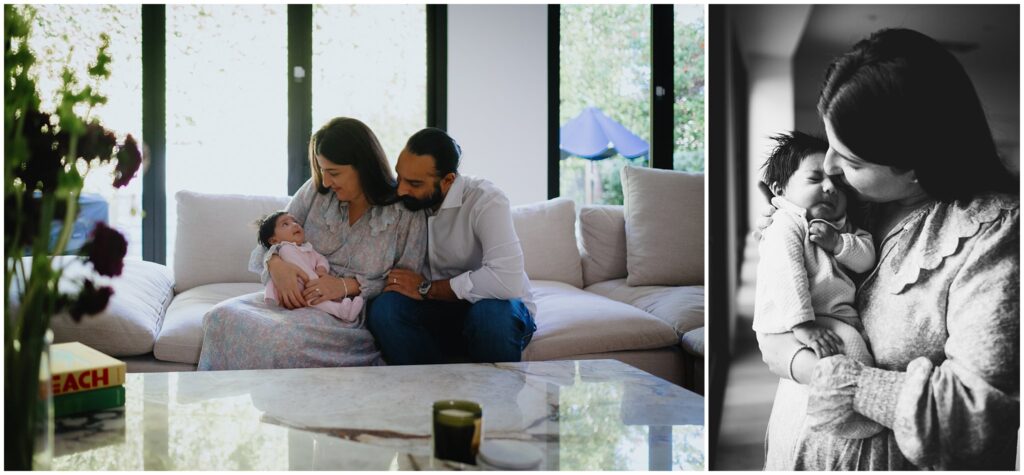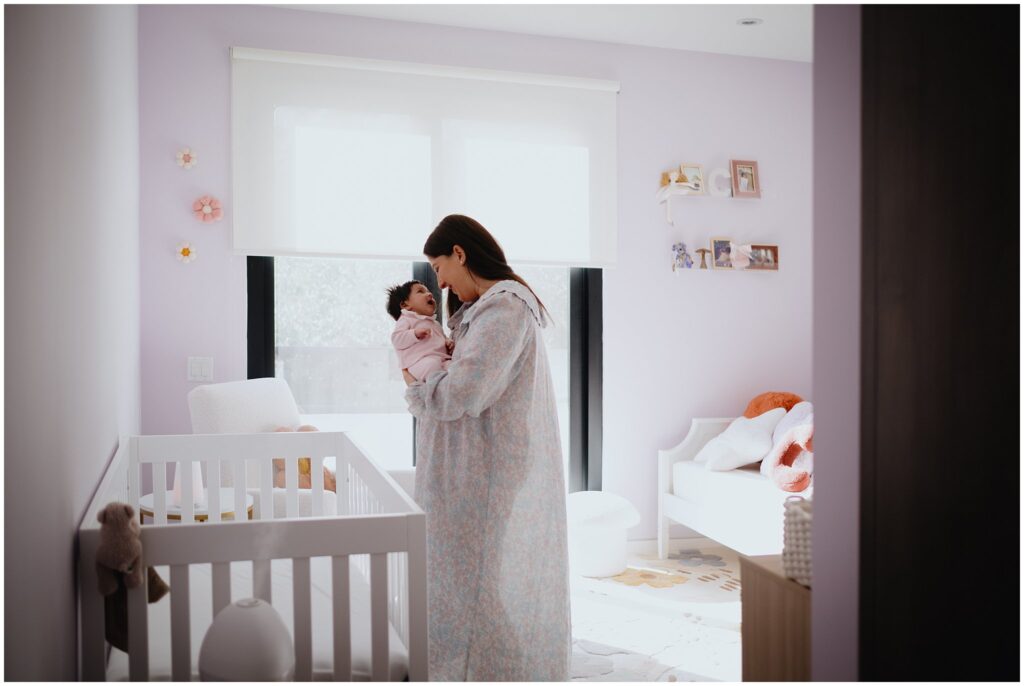Labor and Delivery and Caring for Our Newborn Baby – “I Wish I Knew…” Episode 06

newborn
family
Client tips
parent tips
"I wish I knew"
I'm Marjorie
LOS ANGELES NEWBORN & FAMILY PHOTOGRAPHER
I work with parents who want relaxed and unposed photos, providing them with images that capture the joyful and unscripted moments in life.
More about Me
In this episode of the parenthood documentary series, “I Wish I Knew,” brand new parents, Karina & Uday, walk us through their labor and delivery story and give us a step-by-step description of the birth of their new baby girl.
Labor & Delivery for Newborn Baby
Karina championed through labor, walking into the hospital already 7 centimeters dilated, which is rare for a first-time mom. Within only a couple of hours, and a last-minute epidural, she delivered her baby, Celine.
Karina and Uday describe their experience 9 days postpartum with their newborn. They share their thoughts on unsolicited advice, societal pressure on mothers, and the around-the-clock feeding schedule.
Watch the episode for an honest and detailed account of their first weeks as new parents.

TABLE OF CONTENTS

Labor and Delivery – The 4 Stages of Vaginal Childbirth
“While each labor and birth is unique, the process of a vaginal delivery follows four stages: First Stage (early labor, active labor and transition), Second Stage (pushing and birth), Third Stage (delivery of the placenta), and Fourth Stage (uterus returns to original size).
During Early Labor
What to Expect: You will begin to notice tightening sensations in your abdomen called contractions. These contractions can last up to 60 seconds and can be between 5 to 30 minutes apart. Contractions will increase in strength and frequency as your labor progresses. At this time, your cervix will start to dilate (open) and will reach 6 centimeters by the end of this phase.
How Long It Will Last: Early labor is the longest part of labor and can last 12 to 24 hours or longer if this is your first baby. Because of this, it is important to be patient and try to rest as much as possible.
During Active Labor
What to Expect: Your contractions are stronger, longer and closer together. Contractions can last up to 60 to 90 seconds and are approximately 2 to 5 minutes apart. Dilation typically happens more rapidly in active labor than in early labor, your cervix dilates to 6 to 8 centimeters.
How Long It Will Last: For many people giving birth for the first time, active labor typically lasts 4 to 8 hours.
During Transition
What to Expect: Your contractions are the strongest, longest and closest together. Contractions can last 60 to 120 seconds and are usually 2 to 3 minutes apart. Your cervix dilates from 8 to 10 centimeters and when you reach 10 centimeters, you begin the second stage.
How Long It Will Last: This is usually the shortest part of the first stage of labor.
Second Stage (pushing and birth)
What to Expect: Your cervix has fully dilated to 10 centimeters. You may feel pressure and the urge to push. Your doctor or midwife will let you know when to start pushing.
How Long It Will Last: On average this stage can last 1 ½ to 2 hours with your first baby. However, you only push when you are having a contraction and you can rest in between.
Third and Fourth Stages (after delivery)
What to Expect: Your placenta is delivered. You may experience chills or shakiness during this time. This stage can take up to 30 minutes. Once the placenta is delivered, you enter the fourth stage of labor as your uterus returns to its original size. Many people feel light cramping during this period.”
Visit the link below to read the full article on Labor & Delivery.
Source: Cedars-Sinai Medical Center

What Do Contractions Feel Like?
“Many mothers describe contractions that occur in early labor as similar to menstrual cramps, or as severe gas pains, which may be confused with flu symptoms or intestinal disorders. Imagine your contractions as looking like a wave. Each contraction will gradually gain in intensity until the contraction peaks, then slowly subside and go away. As your body does the work of labor, it is likely that the time in between contractions will become shorter.
As the strength of each contraction increases, the peaks will come sooner and last longer. There should be some regularity or pattern when timed. Persistent contractions that have no rhythm but are five-to-seven minutes apart or less should be reported to your physician or midwife.”
Visit the link below to read the full article on Labor Contractions.
Source: Sutter Health

Dilation During Labor
“There are 3 stages of labor: latent, active, and delivery. Active labor begins at about 5-6 cm of dilation. You need to be 10 cm dilated to deliver vaginally. After the birth, you’ll deliver the placenta.
The cervix, which is the lowest portion of the uterus, opens when a woman has a baby, through a process called cervical dilation. The process of the cervix opening (dilating) is one way that healthcare staff track how a woman’s labor is progressing.
During labor, the cervix opens to accommodate the passage of baby’s head into the vagina, which is around 10 centimeters (cm) dilated for most term babies.
If your cervix is dilated with regular, painful contractions, you’re in active labor and getting closer to delivering your baby.”
Visit the link below to read the full article on Cervix Dilation.
Source: Healthline

Epidurals – Benefits and Side Effects
“How and when is an epidural for labor pain administered?
If you choose to have an epidural, an anesthesiologist will insert a needle and a tiny tube, called a catheter, in the lower part of your back. The needle is removed and the catheter left in place for delivery of the medication through the tube as needed. You can begin an epidural at any time during your labor — in the beginning, in the middle, or even toward the end — in consultation with your physician.
Does it hurt when the epidural is administered?
The anesthesiologist will numb the area where the epidural is administered, which may cause a momentary stinging or burning sensation. But because of this numbing, there is very little pain associated with an epidural injection. Instead, most patients will feel some pressure as the needle is inserted.
What does an epidural do?
An epidural provides anesthesia that creates a band of numbness from your bellybutton to your upper legs. It allows you to be awake and alert throughout labor, as well as to feel pressure. The ability to feel second-stage labor pressure enables you to push when it’s time to give birth to your baby. It can take about 15 minutes for the pain medication to work.
How long does the pain relief last?
You can continue to receive pain relief through an epidural for as long as you need it. The amount of medication you receive through the epidural can be increased or decreased as necessary.
Can an epidural slow labor or lead to a cesarean delivery (C-section)?
There is no credible evidence that it does either. When a woman needs a C-section, other factors usually are at play, including the size or position of the baby or slow progression of labor due to other issues. With an epidural, you might be able to feel contractions — they just won’t hurt — and you’ll be able to push effectively. There is some evidence that epidurals can speed the first stage of labor by allowing the mother to relax.”
Visit the link below for the full article on Epidurals.
Source: American Society of Anesthesiologists

Skin-to-Skin Contact
What is skin-to-skin contact?
“Skin-to-skin contact is usually referred to as the practice where a baby is dried and laid directly on the mother’s bare chest after birth, both of them covered in a warm blanket and left for at least an hour or until after the first feed. Skin-to-skin contact can also take place any time a baby needs comforting or calming and can help boost a mother’s milk supply. Skin-to-skin contact is vital in neonatal units where it is often known as ‘kangaroo care’. Here it helps parents bond with their baby and supports better physical and developmental outcomes for the baby.
Why is skin-to-skin contact important?
There is a growing body of evidence that skin-to-skin contact after the birth helps babies and their mothers. The practice:
- calms and relaxes both mother and baby
- regulates the baby’s heart rate and breathing, helping them to better adapt to life outside the womb
- stimulates digestion and an interest in feeding
- regulates temperature
- enables colonisation of the baby’s skin with the mother’s friendly bacteria, thus providing protection against infection
- stimulates the release of hormones to support breastfeeding and mothering.
Skin-to-skin contact also provides benefits for babies in the neonatal unit, in that it:
- improves oxygen saturation
- reduces cortisol (stress) levels, particularly following painful procedures
- encourages pre-feeding behaviour
- assists with growth
- may reduce hospital stay
- improves milk volume if the mother expresses following a period of skin-to-skin contact, with the expressed milk containing the most up-to-date antibodies.”
Visit the link below for more resources on skin-to-skin contact.
Source: unicef

Cluster Feeding
“Cluster feeding is a time when your baby wants lots of short feeds over a few hours. It’s normal and often happens in the early days of breastfeeding.
Cluster feeding is a normal behaviour for your baby. It’s more common in the late afternoon or early evening, but it can happen anytime of the day.
It seems that some babies prefer to fill up on milk for a few hours then often have a longer sleep.”
Visit the link below to read the full article on Cluster Feeding.
Source: Pregnancy Birth & Baby

About Marjorie
Hi, I’m Marjorie. I’m a Newborn & Family Photographer based in Los Angeles, California, and the creator of this documentary series, “I Wish I Knew… A Series on Parenthood.”

Soon after I started my business and began hanging out with different families, I realized every single parent I knew had gone through something. Everyone had a story.
I decided to use my background in filmmaking to create a platform where parents could share their stories. My hope is that we can learn from each other and normalize events and experiences that have been labeled as taboo.
Sign up to receive the latest episode!
If you’re interested in staying in the loop and being among the first to watch new episodes as they are released, join the email list!
We cover topics such as mental health, pregnancy loss, adoption, divorce, out-of-hospital birth, and more.
Preparing Your Home For Your Photo Session
Easy and stress-free guide on getting your home ready for a photo session. Here’s what you need to do and here’s what you can skip!
5 Quick Tips for
grab your guide
free guide
Post Comments